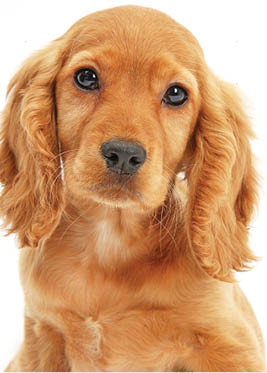 Originally descended from the Land Spaniels of Spain, the Cocker Spaniel was developed in England as a hunting and retrieving dog. The English Cocker Spaniel initially belonged to the large family of Spaniels and got its separate identity from the American Cocker Spaniel in 1892. The description of ‘Cocker’ probably originated from the use of these dogs in hunting woodcock, a bird that dwells in wooded bottomlands and is considered a delicacy. Today, in spite of their popularity as pets, Cocker Spaniels still retain a strong desire to work.
Originally descended from the Land Spaniels of Spain, the Cocker Spaniel was developed in England as a hunting and retrieving dog. The English Cocker Spaniel initially belonged to the large family of Spaniels and got its separate identity from the American Cocker Spaniel in 1892. The description of ‘Cocker’ probably originated from the use of these dogs in hunting woodcock, a bird that dwells in wooded bottomlands and is considered a delicacy. Today, in spite of their popularity as pets, Cocker Spaniels still retain a strong desire to work.
The Cocker’s distinguishing features are its long pendulous ears and soft, soulful eyes. Its long, silky coat comes in as many as twenty-four colours, ranging from solids, parti-colours (coat of two or more solid colours, one of which must be white) and tri-colours. The small sized dog, stands at a height of 15 to 17 inches at the shoulder and weighs 25 to 35 pounds.
Personality: The Cocker is a friendly, playful, affectionate dog – in short, an ideal family pet. The well-bred Cocker Spaniel enjoys human company and is eager to please. Unfortunately, due to the breed’s popularity, poorly bred specimens, with genetic faults and behaviour problems, are flooding the pet market. These dogs often tend to be snappy or highly-strung and are difficult to train and handle. Most Cocker Spaniels are good with children – though, older dogs not exposed to children at an early age, tend to be grouchy around them.
Trainability: Cocker Spaniels are generally eager to please and with gentle handling (they respond poorly to harsh treatment), can be trained in any area. The dog’s food-motivated and intelligent nature makes training with treats and toys a good choice for this breed. Many Cockers like to do tricks and enjoy playing ball as well. Obedience training is necessary for this breed, which can tend to be stubborn and dominant. One of the main problems we tend to see with Cockers is possessive behaviour. Playing games that teach your dog the concept of sharing will go a long way in ensuring your Cocker Spaniel does not end up growling when he has an item.
Health and Care: The Cocker’s long, silky coat can get easily tangled and needs daily brushing out to keep it in glossy condition. In addition, the dog’s pendulous ears tend to trap dirt and moisture, thus making it prone to ear infections. Cocker puppies must be taught at an early age to have their ears handled, for they will need to be tied back to encourage air circulation, and cleaned if infection does develop. The dogs should be fed in deep, narrow bowls that allow them to eat and drink without getting their ears into the food or water. The dog needs a moderate amount of exercise, mostly in the form of play to stay out of mischief and keep healthy. Cockers tend to suffer from cataracts, glaucoma, progressive retinal atrophy and haemophilia. A healthy Cocker can live anywhere between 13 to 16 years.
Those that have lived with Cocker Spaniels know just how easily this dog can worm itself into your heart. If you get one, be prepared to be devoted to the breed!
- The Dark Side Of Pampered Pets: Is Your Kindness Harming Your Dog? - 16 March2024
- Kids And Preventing Dog Bites - 18 March2023
- Ordinary Dogs With Extraordinary Jobs - 13 August2022
